Criollo people
The Criollo (Spanish pronunciation: [ˈkɾjoʎo]) are Latin Americans who are of sole or of mostly Spanish descent; such ancestry distinguishes them both from multi-racial Latin Americans and from Latin Americans of post-colonial (and not necessarily Spanish) European immigrant origin.
| Regions with significant populations | |
|---|---|
| Spanish colonial empire in the Americas | |
| Languages | |
| Spanish | |
| Religion | |
| Predominantly Roman Catholic |
Historically, they were a social class in the hierarchy of the overseas colonies established by Spain beginning in the 16th century, especially in Hispanic America. They comprised the locally born people – almost always of Spanish ancestry, but also sometimes of other European ethnic backgrounds.[1] Although Criollos were legally Spaniards, in practice they ranked below the Iberian-born Peninsulares. Nevertheless, they had preeminence over all the other populations: Amerindians, enslaved Africans and peoples of mixed descent. According to the Casta system, a criollo could have up to 1/8 (one great-grandparent or equivalent) Amerindian ancestry without losing social place (see Limpieza de sangre).[2] Criollos supposedly sought their own identity through the indigenous past, of their own symbols and the exaltation of everything related to the American one. Their identity was strengthened as a result of the Bourbon Reforms of 1700 that changed the Spanish Empire's policies towards its colonies and led to tensions between Criollos and Peninsulares.[3] The growth of local Criollo political and economic strength in the separate colonies, coupled with their global geographic distribution, led them to each evolve separate (both from each other and Spain) organic national identities and viewpoints. Criollos became the main supporters of independence from Spanish rule.
In the Spanish-language countries, the use of this word to refer to a person of Spanish or European ancestry today is obsolete, except in reference to the colonial period. The word Criollo, however, is used usually in some countries but with other very different meanings.
Origin
The word criollo and its Portuguese cognate crioulo are believed by some scholars, including the eminent Mexican anthropologist Gonzalo Aguirre Beltrán, to derive from the Spanish/Portuguese verb criar, meaning "to breed" or "to raise"; however, no evidence supports this derivation in early Spanish literature discussing the origin of the word.[4] Originally, the term was meant to distinguish the members of any foreign ethnic group who were born and "raised" locally, from those born in the group's homeland, as well as from persons of mixed ethnic ancestry. Thus, in the Portuguese colonies of Africa, português crioulo was a locally born white person of Portuguese descent; in the Americas, negro criollo or negro crioulo was a locally-born person of pure black ancestry. In Spanish colonies, an español criollo was an ethnic Spaniard who had been born in the colonies, as opposed to an español peninsular born in Spain.[5]
Spaniards born in the Spanish Philippines are called insulares. Whites born in colonial Brazil, with both parents born in the Iberian Peninsula, were known as mazombos.
Limpieza de sangre or "cleanness of blood" was a legal concept in use since the Spanish Reconquista, and introduced to the Spanish colonies in the Americas to access certain position such as becoming a member of the Inquistion. However, it was more a religious categorization than a racial one. In 15th-century Spain, the concept was used to distinguish old Christians of "pure" unmixed Iberian Christian ancestry (either Southern Spanish Mozarabs or Christians from the northern kingdoms of Spain) from new Christians descending from converted Moriscos (Iberian Muslims) and Sephardim (Iberian Jews), together known as conversos (converts), whose real allegiance was institutionally distrusted as being true converts.
The English word "creole" was a loan from French créole, which in turn is believed to come from Spanish criollo or Portuguese crioulo.
Spanish colonial caste system
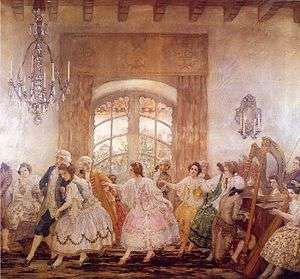
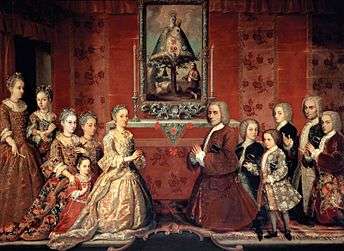
Starting from the 1940s, certain historians have argued that to preserve the Spanish Crown's power in the colonies, the Spanish colonial society was based on an elaborate caste system, which related to a person's degree of descent from Spaniards. The highest-ranking castes were the españoles, Spaniards by birth or descent. The Peninsulares were the persons born in Spain, while the Criollo comprised locally born people of proven unmixed Spanish ancestry, that is, the Americas-born child of two Spanish-born Spaniards or mainland Spaniards (peninsulares), of two Criollos, or a Spaniard and a Criollo. People of mixed ancestry were classified in other castes — such as castizos, mestizos, cholos, mulatos, indios, zambos, and enslaved Africans, called blacks.
A number of historians have explicitly questioned the actual existence of a Caste system in Latin America, considering it a fabrication of Historians starting from the 1940s. Pilar Gonzalbo, in her study La trampa de las castas discards the idea of the existence of a caste society in New Spain, understood as a "social organization based on the race and supported by coercive power".[7] A recent study by Ben Vinson III based on Mexican archives shows how racial diversity operated in Mexico and how it affect both Mexico and imperial Spain.[8] Joanne Rappaport, in her book on colonial New Granada, rejects the caste system as an interpretative framework for that time, discussing both the legitimacy of a model valid for the entire colonial world and the usual association between "caste" and "race".[9] While the casta system was in force, the top ecclesiastical, military and administrative positions were reserved for crown-appointed Peninsulares, while most of the local land-owning nobility belonged to the Criollo caste. In Bolivia, for example, the latter coalesced over time into a native-born upper class that was itself led by a ruling stratum known as the Rosca (lit. "The Screw").
Poole argues that the Virgin Mary, especially as Our Lady of Guadalupe in Mexico, became the chief symbol of religious devotion amongst the criollos. They used the story to legitimize their own social position and infuse it with an almost messianic sense of mission and identity.[10]
Criollo culture
1.jpg)
The Criollos allowed a syncretism in their culture and gastronomy, and they in general felt more identified with the territory where they were born than with the Iberian peninsula, that was demonstrated when they wrote many manuscripts demonstrating an attachment and proud to the natives and their history, even criticizing the crimes of the conquistadores, often denouncing and defending the Natives from abuse, and in the colony's last two centuries the criollos rebelling in arms in response to the harsh suffocation of the Indigenous uprisings. They allowed the Indigenous and mestizos (indigenous/white mixed) to be schooled in the universities and art schools and many natives and mestizos were actually notable painters and architects, mostly in the Andes, but also in Mexico, so the indigenous made European arts with several features marked with Indigenous art traditions, simultaneously Natives continued making pure indigenous art, as a lot of it is preserved.
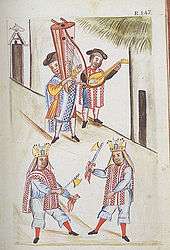
The mixed religious or secular music appears since the 16th century in Spanish and indigenous languages. Baroque music imported from Spain but with European and African instruments (such as drums and congas) appears. The Spanish also introduce a wider musical scale than the indigenous pentatonic, and a melodic and poetic repertoire, transmitted by writings such as songbooks, common of it is the sung voice, common in the European baroque music, the mixed aesthetics are the fruit of diverse contributions indigenous, African and especially, Spanish and European. Instruments introduced by the Spanish are the chirimías, sackbuts, dulcians, orlos, bugles, violas, guitars, violins, harps, organs, etc, along with percussions (that can be indigenous or African), everything converges on music heard by everyone. The Dominican Diego Durán in 1570 write "All the peoples have parties and therefore it is unthinkable to remove them (because it is impossible and because it is not convenient either)", himself parade like the natives with a bouquet of flowers at a Christian party that coincides with the celebration of Tezcatlipoca in Mexico. The Jesuits develop with great success a "pedagogy of theatricality", with this the Society of Jesus attracts the natives and blacks to the church, where children learn to play European instruments. In Quito (1609): "there were many dances of tall and small Indigenous, and there were no lack of Moscas Indigenous who danced in the manner of the New Kingdom [European] (...) and dances of Spaniards and blacks and other dances of the Indigenous must dance before the Blessed Sacrament and in front of the Virgin Mary and the saints at parties and Easter, if they don't do it then they are punished". The well-known Zambra mora was commonly danced by blacks, to the sound of castanets and drums. The Spanish Sarabande was danced by whites and blacks. Blacks also have their chiefs. In these local events, the brotherhoods of the Congos give rise to the Congadas (Brazil, Caribbean).[13]
Actually there were no relevant black artists during the colony, also one must consider the fact that many of the pure blacks were slaves, but the Law of Coartación or "slave law" was created since the 16th century,[14] reaching its maximum peak in the 18th century, which made the black slaves to buy their freedom, through periodic payments to their owner, which eventually led to freedom.[15][16] Others were freed and purchased by families members or allied whites.[14] It was a consetudinary act in Spanish America, it allowed the appearance of a large population of free blacks in all of the territory. Freedom could also be obtained through baptism, with the white recongnising his illegitimate children, his word was sufficient for the newborn child for be declared free.[14] Legal freedom was more common in the cities and towns than the countryside.[14] Also, from the late 1600s to the 19th century, the Spanish encouraged slaves from the British colonies and United States to come to Spanish Florida as a refuge, King Charles II of Spain and his court issued a royal decree freeing all slaves who fled to Spanish Florida and accepted Catholic conversion and baptism (since 1690),[17][18] most went to the area around St. Augustine, but escaped slaves also reached Pensacola and Cuba.[17] Also a substantial number of blacks from Haiti (a French colony) arrived as refugees to Spanish Louisiana because of these greater freedoms.[19] The Spanish Santa Teresa de Mose (Florida) became the first legally sanctioned free black town in the present-day United States.[18] The popularity of the Law of coartación resulted in a large population of free black people in Spanish America.[20]
Also Mexican historian Federico Navarrete comments: that "if they received the surname of the white father and incorporated them into their family, those children counted as american whites having the same rights, regardless of the race",[21] Also a fact is in every marriages, including the most mixed, they are characterized, portrayed and named the caste product that was according to their ancestry, and if this can not, according to their appearance and color.[22]
In several documents mention that indigenous people called Criollos with the same name as one of their gods. For example, Juan Pablo Viscardo relates (1797) that the Indigenous (from Peru) call to the Criollos 'Viracocha';[23] also, he says that Criollos are born in the middle of the Indigenous, are respected, and also loved by many, that they speak the language of the natives (in addition to Spanish) and used to Indigenous customs.[23]
After suppressing the Túpac Amaru II Uprising of 1780 in the viceroyalty of Peru, evidence began against the criollos ill will from the Spanish Crown, especially for the Oruro Rebellion prosecuted in Buenos Aires, and also for the lawsuit filed against Dr. Juan José Segovia, born in Tacna, and Colonel Ignacio Flores, born in Quito, who had served as President of the Real Audiencia of Charcas and had been Governor Mayor of La Plata (Chuquisaca or Charcas, current Sucre).[24]
Criollos and the wars of independence
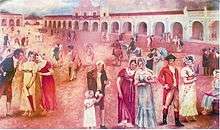
Until 1760, the Spanish colonies were ruled under laws designed by the Spanish Habsburgs which granted the American provinces broad autonomy. That situation changed by the Bourbon Reforms of 1700 during the reign of Charles III. Spain needed to extract increasing wealth from its colonies to support the European and global wars it needed to maintain the Spanish Empire. The Crown expanded the privileges of the Peninsulares, who took over many administrative offices which had been filled by Criollos. At the same time, reforms by the Catholic Church reduced the roles and privileges of the lower ranks of the clergy, who were mostly Criollos. By the 19th century, this discriminatory policy of the Spanish Crown and the examples of the American and French revolutions, led Criollo factions to rebel against the Peninsulares. With increasing support of the other castes, they engaged Spain in a fight for independence (1809–1826). The former Spanish Empire in the Americas separated into a number of independent republics.
Modern colloquial uses
The word criollo retains its original meaning in most Spanish-speaking countries in the Americas. In some countries, however, the word criollo has over time come to have additional meanings, such as "local" or "home-grown". For instance, comida criolla in Spanish-speaking countries refers to "local cuisine", not "cuisine of the criollos". In Portuguese, crioulo is also a racist slang term referring to blacks.[25][26]
In some countries, the term is also used to describe people from particular regions, such as the countryside or mountain areas:
- In Argentina, natives of the northwestern provinces are called criollos by their porteño counterparts from Buenos Aires. They are typically seen as more traditionally Hispanic in culture and ancestry than the melting pot of non-Hispanic European influences (particularly Italian and German) that define the people and culture of Buenos Aires. "Misa criolla" is the name of a very popular mass composed by Ariel Ramirez, and sung by Mercedes Sosa among others.
- In Perú, criollo is associated with the syncretic culture of the Pacific Coast, a mixture of Spanish, African, indigenous, and Gitano elements. Its meaning is, therefore, more similar to that of "Louisiana Creole people" than to the criollo of colonial times.
- In Puerto Rico, natives of the town of Caguas are usually referred to as criollos; professional sports teams from that town are also usually nicknamed Criollos de Caguas ("Caguas Creoles"). Caguas is located near Puerto Rico's Cordillera Central mountain area.
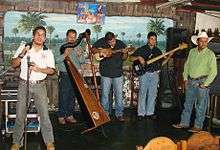
- In Venezuela, criollo is associated with the national culture of Venezuela. Pabellón criollo is Venezuela's national dish and the baseball Corporación Criollitos de Venezuela is a seeder to the well renowned Venezuelan Professional Baseball League among other examples. Música Criolla is a way to refer to Venezuelan traditional music i.e. joropo. In Venezuela, novelists like Rómulo Gallegos with his novel Doña Bárbara, Pedro Emilio Coll, and Luis Manuel Urbaneja Achelpohl with the novel Peonía were major exponents of the Criollismo movement. Criollo also often refers to a mongrel dog, or something traditional to the country or its citizens.
- In Cuba and Colombia, the word Criollo has similar meanings with those of Venezuela.
In Mexico
Colonial period
As early as the sixteenth century in the colonial period in New Spain, criollos, or the "descendants of Spanish colonists,"[27] began to "distinguish themselves from the richer and more powerful peninsulares," who they referred to as gachupines (wearer of spurs), as an insult. At the same time, Mexican-born Spaniards were referred to as criollos, initially as a term which was meant to insult. However, over time, "those insulted who were referred to as criollos began to reclaim the term as an identity for themselves.[28] In 1563, the criollo sons of Spanish conquistador Hernán Cortés, attempted to remove Mexico from Spanish-born rule and place Martín, their half-brother, in power. However, their plot failed and they, along with many others involved, were beheaded by the Spanish monarchy, which suppressed expressions of open resentment from the criollos towards peninsulares for a short period. By 1623, criollos were involved in open demonstrations and riots in Mexico in defiance of their second-class status. In response, a visiting Spaniard by the name of Martín Carrillo noted, "the hatred of the mother country's domination is deeply rooted, especially among the criollos."[29]
Despite being descendants of Spanish colonizers, many criollos in the period peculiarly "regarded the Aztecs as their ancestors and increasingly identified with the Indians out of a sense of shared suffering at the hands of the Spanish." Many felt that the story of the Virgin of Guadalupe, published by criollo priest Miguel Sánchez in Imagen de la Virgin Maria (Appearance of the Virgin Mary) in 1648, "meant that God had blessed both Mexico and particularly criollos, as "God's new chosen people."[29] By the eighteenth century, although restricted from holding elite posts in the colonial government, the criollos notably formed the "wealthy and influential" class of major agriculturalists, "miners, businessmen, physicians, lawyers, university professors, clerics, and military officers." Because criollos were not perceived as equals by the Spanish peninsulares, "they felt they were unjustly treated and their relationship with their mother country was unstable and ambiguous: Spain was, and was not, their homeland," as noted by Mexican writer Octavio Paz.[27]
They [criollos] felt the same ambiguity in regard to their native land. It was difficult to consider themselves compatriots of the Indians and impossible to share their pre-Hispanic past. Even so, the best among them, if rather hazily, admired the past, even idealized it. It seemed to them that the ghost of the Roman empire had at times been embodied in the Aztec empire. The criollo dream was the creation of a Mexican empire, and its archetypes were Rome and Tenochtitlán. The criollos were aware of the bizarre nature of their situation but, as happens in such cases, they were unable to transcend it — they were enmeshed in nets of their own weaving. Their situation was cause for pride and for scorn, for celebration and humiliation. The criollos adored and abhorred themselves. [...] They saw themselves as extraordinary, unique beings and were unsure whether to rejoice or weep before that self-image. They were bewitched by their own uniqueness.[27]
Independence movement
As early as 1799, open riots against Spanish colonial rule were unfolding in Mexico City, foreshadowing the emergence of a fully-fledged independence movement. At the conspiración de los machetes, soldiers and criollo traders attacked colonial properties "in the name of Mexico and the Virgen de Guadalupe." As news of Napoleon I's armies occupying Spain reached Mexico, Spanish-born peninsulares such as Gabriel de Yermo strongly opposed criollo proposals of governance, deposed the viceroy, and assumed power. However, even though Spaniards maintained power in Mexico City, revolts in the countryside were quickly spreading.[30]
Ongoing resentment between criollos and peninsulares erupted after Napoleon I deposed Charles IV of Spain of power, which, "led a group of peninsulares to take charge in Mexico City and arrest several officials, including criollos." This, in turn, motivated criollo priest Miguel Hidalgo y Costilla to begin a campaign for Mexican independence from Spanish colonial rule. Launched in Hidalgo's home city of Dolores, Guanajuato in 1810, Hidalgo's campaign gained support among many "Indians and mestizos, but despite seizing a number of cities," his forces failed to capture Mexico City. In the summer of 1811, Hidalgo was captured by the Spanish and executed. Despite being led by a criollo, many criollos did not initially join the Mexican independence movement and it was reported that "fewer than one hundred criollos fought with Hidalgo," despite their shared caste status. While many criollos in the period resented their "second-class status" compared to peninsulares, they were "afraid that the overthrow of the Spanish might mean sharing power with Indians and mestizos, whom they considered to be their inferiors." Additionally, due to their privileged social class position, "many criollos had prospered under Spanish rule and did not want to threaten their livelihoods."[29]
Criollos only undertook direct action in the Mexican independence movement when new Spanish colonial rulers threatened their property rights and church power, an act which was "deplored by most criollos" and therefore brought many of them into the Mexican independence movement.[29] Mexico gained its independence from Spain in 1821 under the coalitionary leadership of conservatives, former royalists, and criollos, who detested Emperor Ferdinand VII's adoption of a liberal constitution which threatened their power. This coalition created the Plan de Iguala, which concentrated power in the hands of the criollo elite as well as the church under the authority of criollo Agustín de Iturbide who became Emperor Agustín I of the Mexican Empire.[31] Iturbide was the son of a "wealthy Spanish landowner and a Mexican mother" who ascended through the ranks of the Spanish colonial army to become a colonel. Iturbide reportedly fought against "all the major Mexican independence leaders since 1810, including Hidalgo, José María Morelos y Pavón, and Vicente Guerrero," and according to some historians, his "reasons for supporting independence had more to do with personal ambition than radical notions of equality and freedom."[29]
Post-independence
Mexican independence from Spain in 1821 resulted in the beginning of criollo rule in Mexico as they became "firmly in control of the newly independent state." Although direct Spanish rule was now gone, "by and large, Mexicans of primarily European descent governed the nation."[32] The period was also marked by the expulsion of the peninsulares from Mexico, of which a substantial source of "criollo pro-expulsionist sentiment was mercantile rivalry between Mexicans and Spaniards during a period of severe economic decline," internal political turmoil, and substantial loss of territory.[33] Leadership "changed hands 48 times between 1825 and 1855" alone "and the period witnessed both the Mexican-American War and the loss of Mexico's northern territories to the United States in the Treaty of Guadalupe Hidalgo and the Gadsden Purchase." Some credit the "criollos' inexperience in government" and leadership as a cause for this turmoil. It was only "under the rule of noncriollos such as the Indian Benito Juárez and the mestizo Porfiro Díaz" that Mexico "experienced relative [periods of] calm."[29]
By the late nineteenth and early twentieth centuries, the criollo identity "began to disappear," with the institution of mestizaje and Indigenismo policies by the national government, which stressed a uniform homogenization of the Mexican population under the "mestizo" identity. As a result, "although some Mexicans are closer to the ethnicity of criollos than others" in contemporary Mexico, "the distinction is rarely made." During the Chicano movement, when leaders promoted the ideology of the "ancient homeland of Aztlán as a symbol of unity for Mexican Americans, leaders of the 1960s Chicano movement argued that virtually all modern Mexicans are mestizos."[29]
In the United States
As the United States expanded westward, it annexed lands with a long-established population of Spanish-speaking settlers, who were overwhelmingly or exclusively of white Spanish ancestry (cf. White Mexican). This group became known as Hispanos. Prior to incorporation into the United States (and briefly, into Independent Texas), Hispanos had enjoyed a privileged status in the society of New Spain, and later in post-colonial Mexico.
Regional subgroups of Hispanos were named for their geographic location in the so-called "internal provinces" of New Spain:
- Californios in Las Californias ("The Californias"), and later Alta California ("Upper California")
- Nuevomexicanos in Spanish New Mexico, and later Mexican New Mexico (Nuevo México)
- Tejanos in Spanish Texas, and later Mexican Texas (Tejas)
Another group of Hispanos, the Isleños ("Islanders"), are named after their geographic origin in the Old World, namely the Canary Islands. In the US today, this group is primarily associated with the state of Louisiana.
See also
|
|
Further reading
- José Presas y Marull (1828). Juicio imparcial sobre las principales causas de la revolución de la América Española y acerca de las poderosas razones que tiene la metrópoli para reconocer su absoluta independencia. (original document) [Fair judgment about the main causes of the revolution of Spanish America and about the powerful reasons that the metropolis has for recognizing its absolute independence]. Burdeaux: Imprenta de D. Pedro Beaume.
Notes
- The father, don Francisco de Fagoaga, wears the badge that accredits him as a knight of the Military Order of Santiago. He entered in the order in 1734.[6]
References
- Donghi, Tulio Halperín (1993). The Contemporary History of Latin America. Duke University Press. p. 49. ISBN 0-8223-1374-X.
- Carrera, Magali M. (2003). Imagining Identity in New Spain: Race, Lineage, and the Colonial Body in Portraiture and Casta Paintings (Joe R. and Teresa Lozano Long Series in Latin American and Latino Art and Culture). University of Texas Press. p. 12. ISBN 978-0-292-71245-4.
- Mike Duncan (12 June 2016). "Revolutions Podcast" (Podcast). Mike Duncan. Retrieved 28 August 2016.
- Peter A. Roberts (2006). "The odyssey of criollo". In Linda A. Thornburg; Janet M. Miller (eds.). Studies in Contact Linguistics: Essays in Honor of Glenn G. Gilbert. Peter Lang. p. 5. ISBN 978-0-8204-7934-7.
- Genealogical historical guide to Latin America – Page 52
- "Retrato de la familia Fagoaga-Arozqueta". electronic magazine Imágenes of the Institute of Aesthetic Research of the National Autonomous University of Mexico.
- Gonzalbo Aizpuru, Pilar, "La trampa de las castas" in Alberro, Solange and Gonzalbo Aizpuru, Pilar, La sociedad novohispana. Estereotipos y realidades, México, El Colegio de México, 2013, p. 15–193.
- Vinson, Ben III. Before Mestizaje: The Frontiers of Race and Caste in Colonial Mexico. New York: Cambridge University Press 2018.
- Rappaport, Joanne. The Disappearing Mestizo: Configuring Difference in the Colonial Kingdom of New Granada. Durham: Duke University Press 2014.
- Stafford Poole, Our Lady of Guadalupe: The Origins and Sources of a Mexican National Symbol, 1531–1797 (1995)
- "POESÍA QUECHUA EN GUAMAN POMA DE AYALA Y BLAS VALERA". victormazzihuaycucho.blogspot.com. 14 April 2011.
- "CANTO DE CRIOLLOS CON GUITARRA (traducción al Español)".
- Carmen Bernand (19 August 2009). "Musiques métisses, musiques populaires, musiques latines: genèse coloniale, identités républicaines et globalisation". Sorbonne University. France. ISSN 1794-5887.
- Doudou Diène (2001). From Chains to Bonds: The Slave Trade Revisited. Paris: UNESCO. p. 387. ISBN 92-3-103439-1.
- Miguel Vega Carrasco (3 February 2015). "La "coartación" de esclavos en la Cuba colonial". descubrirlahistoria.es.
- Manuel Lucena Salmoral (1999). "El derecho de coartación del esclavo en la América española". Revista de Indias, Spanish National Research Council. Cite journal requires
|journal=(help) - Gene A. Smith, Texas Christian University, Sanctuary in the Spanish Empire: An African American officer earns freedom in Florida, National Park Service
- "Fort Mose. America's Black Colonial Fortress of Freedom". Florida Museum of Natural History.
- Alejandro de la Fuente; Ariela J Gross. Becoming Free, Becoming Black: Race, Freedom, and the Law in Cuba, Virginia, and Louisiana; Studies in Legal History. Cambridge University Press. p. 115. ISBN 978-1-108-48064-2.
- Proctor, III, Frank "Trey" (2006). Palmer, Colin A. (ed.). "Coartacion". Encyclopedia of African-American Culture and History. Detroit: Macmillan Reference USA. 2: pp= 490–493
- Federico Navarrete (12 October 2017). "Criollos, mestizos, mulatos o saltapatrás: cómo surgió la división de castas durante el dominio español en América". BBC.
- Carlos López Beltrán. "Sangre y Temperamento. Pureza y mestizajes en las sociedades de castas americanas" (PDF). National Autonomous University of Mexico.
- María Luisa Rivara de Tuesta (Juan Pablo Vizcardo y Guzmán). Ideólogos de la Emancipación peruana (PDF). National University of San Marcos. p. 39.
- José Oscar Frigerio, La rebelión criolla de Oruro. Principales causas y perspectivas, Anuario de Estudios Americanos, tomo LII, nº 1, Sevilla, 1995; José Oscar Frigerio, La rebelión criolla de Oruro fue juzgada en Buenos Aires (1781–1801), Ediciones del Boulevard, Córdoba, 2011.
- "Portugal: Autarca proíbe funcionária de falar crioulo – Primeiro diário caboverdiano em linha". A Semana. Archived from the original on 2015-11-25. Retrieved 2015-11-24.
- "Racismo na controversa UnB – Opinião e Notícia". Opiniaoenoticia.com.br. Retrieved 2015-11-24.
- Paz, Octavio (1990). Mexico: Splendors of Thirty Centuries. Bulfinch Press. p. 26. ISBN 9780821217979.
- Lasso de la Vega, Luis (1998). Sousa, Lisa; Poole C.M., Stafford; Lockhart, James (eds.). The Story of Guadalupe: Luis Laso de la Vega's Huei tlamahuiçoltica of 1649. Stanford University Press. p. 2. ISBN 9780804734837.
- Campbell, Andrew (2002). Stacy, Lee (ed.). Mexico and the United States. Marshall Cavendish Corp. pp. 245–246. ISBN 9780761474036.
- Caistor, Nick (2000). Mexico City: A Cultural and Literary Companion. Interlink Pub Group Inc. pp. 20. ISBN 9781566563499.
- Himmel, Kelly F. (1999). The Conquest of the Karankawas and the Tonkawas: 1821–1859. Texas A&M University Press. p. 6. ISBN 9780890968673.
- Levinson, I (2002). Armed Diplomacy: Two Centuries of American Campaigning. DIANE. pp. 1–2.
- Sims, Harold (1990). The Expulsion of Mexico's Spaniards, 1821–1836. University of Pittsburgh Press. p. 18. ISBN 9780822985242.
Bibliography
- Will Fowler. Latin America, 1800–2000: Modern History for Modern Languages. Oxford University Press, 2000. ISBN 978-0-340-76351-3
- Carrera, Magali Marie (2003). Imagining Identity in New Spain: Race, Lineage, and the Colonial Body in Portraiture and Casta Paintings. Joe R. and Teresa Lozano Long Series in Latin American and Latino Art and Culture. Austin: University of Texas. ISBN 978-0-292-71245-4.
- https://web.archive.org/web/20111003084354/http://www.rena.edu.ve/cuartaEtapa/literatura/ModerCriollismo.html
_1860_000.jpg)